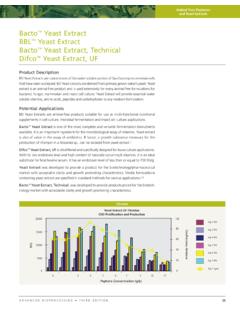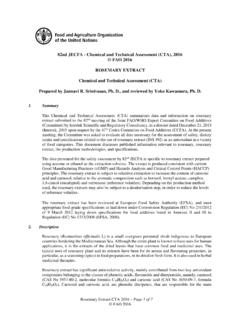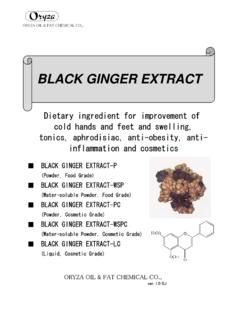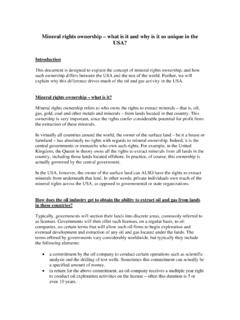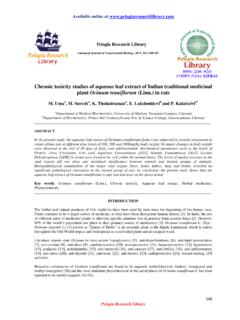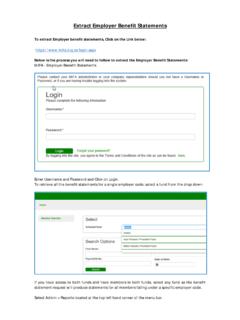Transcription of LYCOPENE EXTRACT FROM TOMATO Chemical …
1 Page 1 of (9) LYCOPENE EXTRACT FROM TOMATO Chemical and Technical Assessment (CTA) Prepared by Susanne Rath, , and reviewed by Zofia Olempska-Beer, , and Paul M. Kuznesof, 1. Summary LYCOPENE EXTRACT from TOMATO is a LYCOPENE -rich EXTRACT prepared from the ripe fruits of TOMATO (Lycopersicon esculentum L.). The product is manufactured by crushing tomatoes, to produce crude TOMATO juice that is then separated into serum and pulp. The pulp is subsequently extracted using ethyl acetate as a solvent. The final EXTRACT consists of TOMATO oil in which LYCOPENE together with a number of other constituents that occur naturally in TOMATO , are dissolved and dispersed.
2 These constituents include fatty acids and acylglycerols, unsaponifiable matter, water soluble matter, phosphorous compounds, and phospholipids. The major colouring principle in TOMATO EXTRACT is all-trans- LYCOPENE , however, minor amounts of cis-isomers and other carotenoids and related substances including -carotene, phytofluene, phytoene and tocopherols are also present. The intended use of LYCOPENE EXTRACT from TOMATO is as a food colour in dairy products, non-alcoholic flavoured drinks, cereal and cereal products, bread and baked goods and spreads, to provide colour shades from yellow to red.
3 LYCOPENE EXTRACT from TOMATO may also be used in food supplements. The use levels of the EXTRACT , expressed as LYCOPENE added to food, may vary from 2 mg/l in bottled water to 130 mg/kg in ready-to-eat cereals. LYCOPENE in the EXTRACT was shown to be stable when stored at room temperature and at 4 C for up to 37 months. When used as a food colour, LYCOPENE remained stable in the food matrix under appropriate storage conditions. LYCOPENE stability depends on the particular food to which it is added, as well as on the production process. This Chemical and Technical Assessment is partly based on data and information submitted by LycoRed Natural Products Industries Ltd1.
4 2. Introduction The major colouring principle of LYCOPENE EXTRACT from TOMATO is all-trans- LYCOPENE . LYCOPENE in tomatoes and TOMATO products consists predominantly of all-trans- LYCOPENE (35-96% of the total LYCOPENE content) and low levels of cis-lycopenes (1-22% of the total LYCOPENE content) (Schierle et al., 1997). LYCOPENE for food use is also manufactured by Chemical synthesis or produced by fermentation of Blakeslea trispora. The LYCOPENE content in TOMATO typically ranges from 70 to 130 mg/kg and depends on the variety, geographic location, technique of cultivation, climatic conditions and degree of ripeness of TOMATO fruits.
5 The TOMATO EXTRACT described in this application is the ethyl acetate EXTRACT of ripe TOMATO fruits with LYCOPENE content ranging from 150 to 250 mg/kg. The LYCOPENE content of TOMATO EXTRACT ranges from 5% to 15%, depending on the nature of the fruit from which it was extracted, and the amount of TOMATO seed oil that is included in the EXTRACT . The Joint FAO/WHO Expert Committee on Food Additives (JECFA) had previously evaluated LYCOPENE (both natural and synthetic) to be used as a food colour at its eighth, eighteenth, and twenty-first meetings (FAO/WHO, 1965, 1975, 1978), but was not able to establish an Acceptable Daily Intake (ADI) due to the limited information available.
6 At its sixty-seventh meeting JECFA agreed that both synthetic LYCOPENE and LYCOPENE extracted from Blakeslea trispora were acceptable as food colours and established a group ADI of mg/kg bw/day for both preparations (FAO/WHO, 2007). 1 LycoRed Natural Products Industries Ltd, Box 320 Beer-Sheva, 84102 Israel Page 2 of (9) 3. Description LYCOPENE EXTRACT from TOMATO is a dark-red viscous liquid. It is freely soluble in ethyl acetate and n-hexane, partially soluble in ethanol and acetone, and insoluble in water. A solution in n-hexane shows an absorption maximum at approximately 472 nm.
7 4. Method of manufacture LYCOPENE EXTRACT from TOMATO is produced from a TOMATO variety with high LYCOPENE content, within the range of 150 to 250 mg/kg. This particular variety is not generally marketed for direct consumption, but is used primarily in the production of this LYCOPENE EXTRACT . The EXTRACT is produced by crushing tomatoes into crude TOMATO juice that is then separated into serum and pulp. The TOMATO pulp is then extracted with ethyl acetate. The final product is obtained after solvent removal by evaporation under vacuum at 40-60 C. 5. Characterization Composition LYCOPENE EXTRACT from TOMATO contains carotenoids (5-15% w/w) as well as non-carotenoid components.
8 The carotenoid fraction of the TOMATO EXTRACT consists mainly of lycopenes, of which ~86 % is all-trans- LYCOPENE , ~6% is 5-cis- LYCOPENE , ~2% is 9-cis- LYCOPENE and ~2% is 13-cis- LYCOPENE , and ~4% are other carotenoids. The major non-carotenoid components of TOMATO EXTRACT include fatty acids and acylglycerols (69-74%), phospholipids ( ), and waxes ( ). The Chemical composition of TOMATO EXTRACT as provided to the Committee is detailed in Table 1. The reported values were determined using the analytical methods described in the report of a study that aimed at a full qualitative and quantitative characterization of the EXTRACT .
9 Table 1. Chemical composition of LYCOPENE EXTRACT from TOMATO Content [%] Compound Min Max. Unsaponifiable matter LYCOPENE Phytoene Phytofluene -Carotene Tocopherols Sterols Others ( waxes) 15 Fatty acids and acylglycerols of which* Myristic acid (14:0) Palmitic acid (16:0) Stearic acid (18:0) Oleic acid (18:1) Linoleic acid (18:2) Linolenic acid (18:3) Arachidic acid (20:0) Behenic acid (22:0) Free fatty acids 69 5 74 Water Page 3 of (9) Content [%] Compound Min Max.
10 Water and soluble matter Lactic acid Other organic acids Others Total Phosphorus Organic phosphorus Phospholipids (estimated from phosphorus determined by ICP) 14 Nitrogen Ash * % of total peak area All-trans- LYCOPENE is an unsaturated acyclic hydrocarbon with Chemical formula C40H56 and molecular weight of Its Chemical Abstract Service (CAS) Number is 502-65-8. The Chemical name of all-trans- LYCOPENE is (all-E)-2,6,10,14,19,23,27,31-octamethyl -2,6,8,10,12,14,16,18,20,22,24,26,30-dot riacontatridecaene.










